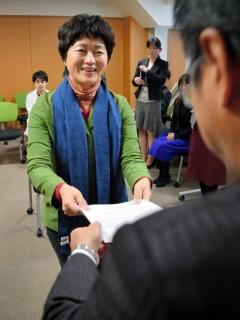Loading
Search
▼ S. Korean Doctor Learns Lessons In Care In Aging Town In Tottori
- Category:Other
HINO, Tottori Prefecture--A veteran South Korean journalist who became a doctor is now treating patients in an aging and shrinking Japanese town with an eye on preparing her home country for a graying society.
Lee Yong-ee, 54, started working as an internal medicine doctor at public-supported Hino Hospital in Hino, Tottori Prefecture, in December, after completing a clinical training course at Yonago-based Tottori University Hospital.
“Hino’s population has been shrinking and increasingly aged,” Lee said. “I will work hard so that residents will not regret visiting our hospital.”
Lee, who is from Seoul, worked as a news reporter for Dong-A Ilbo for 18 years and was its Tokyo correspondent for three years until February 2003.
She decided to become a doctor after watching a physician in a film about a country in dire poverty and meeting volunteer doctors when she traveled in Nepal.
She quit her job and studied medicine at a South Korean university. In 2011, at the age of 47, Lee became a doctor.
Wanting to devote herself to regional medicine, she worked at a medical center in a rural area of South Korea’s Gangwon-do province, which has signed a friendship agreement with Tottori Prefecture.
After hearing about local health care in Japan, she decided to return to the country to study the measures Japanese doctors were taking for their increasing number of elderly patients. She chose Tottori Prefecture as her clinical training site.
Lee obtained a physician’s license in Japan in April 2016. But she also needed to complete the training course to work as a physician in the country.
She passed the test for trainees and was enrolled in the internal and emergency medicine course for five months at Tottori University Hospital from April.
She learned about regional health care at Tottori University Hospital’s partner medical facility, Hino Hospital, for three months.
On Dec. 14, she received her certificate, making her the first non-Japanese doctor to complete the clinical training course at Tottori University Hospital.
“You have finished the course in a foreign land, and I expect you to contribute to regional health care,” Tasuku Harada, director of Tottori University Hospital, told Lee at the Dec. 14 ceremony.
According to the hospital, clinical training normally continues for two years to allow physicians to gain comprehensive knowledge about their duties. However, the health ministry allowed Lee to finish the course in eight months, given her experience of working as a doctor in South Korea.
She currently takes care of patients at Hino Hospital and will be allowed to see outpatients from 2019.
Lee, who studied Japanese at Keio University, is fluent in the language, but she is extra careful to ensure that she conveys the correct nuances and subtleties on diagnosis and other topics to her patients and colleagues.
With her connections to high-ranking officials in the South Korean government, Lee is looking to share her knowledge and data accumulated in Japan for Seoul’s health-care policies.
Lee Yong-ee, 54, started working as an internal medicine doctor at public-supported Hino Hospital in Hino, Tottori Prefecture, in December, after completing a clinical training course at Yonago-based Tottori University Hospital.
“Hino’s population has been shrinking and increasingly aged,” Lee said. “I will work hard so that residents will not regret visiting our hospital.”
Lee, who is from Seoul, worked as a news reporter for Dong-A Ilbo for 18 years and was its Tokyo correspondent for three years until February 2003.
She decided to become a doctor after watching a physician in a film about a country in dire poverty and meeting volunteer doctors when she traveled in Nepal.
She quit her job and studied medicine at a South Korean university. In 2011, at the age of 47, Lee became a doctor.
Wanting to devote herself to regional medicine, she worked at a medical center in a rural area of South Korea’s Gangwon-do province, which has signed a friendship agreement with Tottori Prefecture.
After hearing about local health care in Japan, she decided to return to the country to study the measures Japanese doctors were taking for their increasing number of elderly patients. She chose Tottori Prefecture as her clinical training site.
Lee obtained a physician’s license in Japan in April 2016. But she also needed to complete the training course to work as a physician in the country.
She passed the test for trainees and was enrolled in the internal and emergency medicine course for five months at Tottori University Hospital from April.
She learned about regional health care at Tottori University Hospital’s partner medical facility, Hino Hospital, for three months.
On Dec. 14, she received her certificate, making her the first non-Japanese doctor to complete the clinical training course at Tottori University Hospital.
“You have finished the course in a foreign land, and I expect you to contribute to regional health care,” Tasuku Harada, director of Tottori University Hospital, told Lee at the Dec. 14 ceremony.
According to the hospital, clinical training normally continues for two years to allow physicians to gain comprehensive knowledge about their duties. However, the health ministry allowed Lee to finish the course in eight months, given her experience of working as a doctor in South Korea.
She currently takes care of patients at Hino Hospital and will be allowed to see outpatients from 2019.
Lee, who studied Japanese at Keio University, is fluent in the language, but she is extra careful to ensure that she conveys the correct nuances and subtleties on diagnosis and other topics to her patients and colleagues.
With her connections to high-ranking officials in the South Korean government, Lee is looking to share her knowledge and data accumulated in Japan for Seoul’s health-care policies.
- January 1, 2019
- Comment (0)
- Trackback(0)


